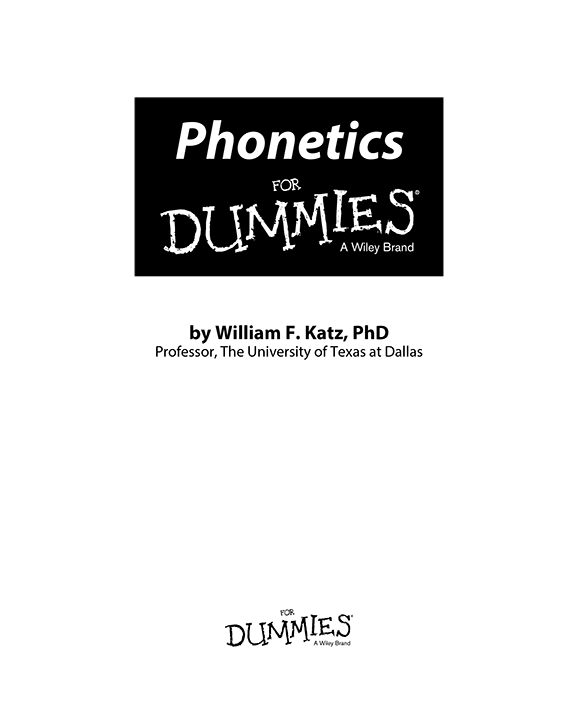
Phonetics For Dummies
Published by: John Wiley & Sons, Inc., 111 River Street, Hoboken, NJ 07030-5774, www.wiley.com
Copyright 2013 by John Wiley & Sons, Inc., Hoboken, New Jersey
Published simultaneously in Canada
No part of this publication may be reproduced, stored in a retrieval system or transmitted in any form or by any means, electronic, mechanical, photocopying, recording, scanning or otherwise, except as permitted under Sections 107 or 108 of the 1976 United States Copyright Act, without the prior written permission of the Publisher. Requests to the Publisher for permission should be addressed to the Permissions Department, John Wiley & Sons, Inc., 111 River Street, Hoboken, NJ 07030, (201) 748-6011, fax (201) 748-6008, or online at http://www.wiley.com/go/permissions .
Trademarks: Wiley, For Dummies, the Dummies Man logo, Dummies.com, Making Everything Easier, and related trade dress are trademarks or registered trademarks of John Wiley & Sons, Inc., and may not be used without written permission. All other trademarks are the property of their respective owners. John Wiley & Sons, Inc., is not associated with any product or vendor mentioned in this book.
Limit of Liability/Disclaimer of Warranty : while the publisher and author have used their best efforts in preparing this book, they make no representations or warranties with respect to the accuracy or completeness of the contents of this book and specifically disclaim any implied warranties of merchantability or fitness for a particular purpose. no warranty may be created or extended by sales representatives or written sales materials. The advise and strategies contained herein may not be suitable for your situation. you should consult with a professional where appropriate. neither the publisher nor the author shall be liable for damages arising herefrom.
For general information on our other products and services, please contact our Customer Care Department within the U.S. at 877-762-2974, outside the U.S. at 317-572-3993, or fax 317-572-4002. For technical support, please visit www.wiley.com/techsupport .
Wiley publishes in a variety of print and electronic formats and by print-on-demand. Some material included with standard print versions of this book may not be included in e-books or in print-on-demand. If this book refers to media such as a CD or DVD that is not included in the version you purchased, you may download this material at http://booksupport.wiley.com . For more information about Wiley products, visit www.wiley.com .
ISBN 978-1-118-50508-3 (pbk); ISBN 978-1-118-50509-0 (ebk); 978-1-118-50510-6 (ebk); 978-1-118-50511-3 (ebk)
Manufactured in the United States of America
10 9 8 7 6 5 4 3 2 1
Introduction
W elcome to the world of phonetics the few, the bold, the chosen. Youre about to embark on a journey that will enable you to make sounds you never thought possible and to scribble characters in a secret language so that only fellow phoneticians can understand what youre doing. This code, the International Phonetic Alphabet (IPA), is a standard among phoneticians, linguists, teachers, and clinicians worldwide.
Phonetics is the scientific study of the sounds of language. Phonetics includes how speech sounds are produced ( articulatory phonetics ), the physical nature of the sounds themselves ( acoustic phonetics ), and how speech is heard by listeners ( perceptual/linguistic phonetics ).
The information you can gain in an introductory college course on phonetics is essential if youre interested in language learning or teaching. Understanding phonetic transcription (that special code language) is critical to anyone pursuing a career in speech language pathology or audiology.
Others can also benefit from studying phonetics. Actors and actresses can greatly improve the convincingness of the characters they portray by adding a basic knowledge of phonetic principles to their background and training. Doing so can make a portrayed accent much more consistent and believable. And if youre a secret drama queen, you can enjoy the fun of trying very different language sounds by using principles of articulatory and acoustic phonetics. No matter what your final career, a basic phonetics class will help you understand how spoken languages work, letting you see the world of speech and language in a whole new light.
About This Book
Phonetics For Dummies gives you an introduction to the scientific study of speech sounds, which includes material from articulatory, acoustic, and perceptual phonetics.
I introduce the field of phonology (systems of sound rules in language) and explain how to classify speech sounds using the IPA. I provide examples from foreign accents, dialectology, communication disorders, and childrens speech.
I present all the material in a modular format, just like all the other For Dummies books, which means you can flip to any chapter or section and read just what you need without having to read anything else. You just need to adhere to some basic ground rules when reading this book and studying phonetics in your class. Here are the big three:
 Study the facts and theory. Phonetics covers a broad range of topics, including physiology, acoustics, and perception, which means you need to familiarize yourself with a lot of new terminology. The more you study, the better youll become.
Study the facts and theory. Phonetics covers a broad range of topics, including physiology, acoustics, and perception, which means you need to familiarize yourself with a lot of new terminology. The more you study, the better youll become.
 Practice speaking and listening. An equally important part of being successful is ear training and oral practice (like learning to speak a second language). To get really good at the practical part of the trade, focus on the speaking and listening exercises that I provide throughout the book.
Practice speaking and listening. An equally important part of being successful is ear training and oral practice (like learning to speak a second language). To get really good at the practical part of the trade, focus on the speaking and listening exercises that I provide throughout the book.
 Stay persistent and dont give up. Some principles of phonetics are dead easy, whereas others are trickier. Also, many language sounds can be mastered on the first try, whereas others can even take expert phoneticians (such as Peter Ladefoged) up to 20 years to achieve. Keep at it and the payoff will be worth it!
Stay persistent and dont give up. Some principles of phonetics are dead easy, whereas others are trickier. Also, many language sounds can be mastered on the first try, whereas others can even take expert phoneticians (such as Peter Ladefoged) up to 20 years to achieve. Keep at it and the payoff will be worth it!
You can only pack so much into a book nowadays, so I have also recommended many Internet websites that contain more information. These links can be especially helpful for phonetics because multimedia (sound and video) is a powerful tool for mastering speech.
Conventions Used in This Book
This book uses several symbols commonly employed by phoneticians worldwide. If theyre new to you, dont worry. They were foreign to even the most expert phoneticians once. Check out these conventions to help you navigate your way through this book (and also in your application of phonetics):
 / /: Angle brackets (or slash marks) denote broad, phonemic (indicating only sounds that are meaningful in a language) transcription.
/ /: Angle brackets (or slash marks) denote broad, phonemic (indicating only sounds that are meaningful in a language) transcription.
 [ ]: Square brackets mark narrow, phonetic transcription. This more detailed representation captures language-particular rules that are part of a languages phonology.
[ ]: Square brackets mark narrow, phonetic transcription. This more detailed representation captures language-particular rules that are part of a languages phonology.
 / kt / or cat: This transcription is the International Phonetic Alphabet (IPA) in action. The IPA is a system of notation designed to represent the sounds of the spoken languages of the world. I use the IPA in slash marks ( broad transcription ) for more general description of language sounds (/ kt /), and the IPA in square brackets ( narrow transcription ) to capture greater detail ([ kt ]). I use quotation marks for spelled examples so you dont mistake the letters for IPA symbols.
/ kt / or cat: This transcription is the International Phonetic Alphabet (IPA) in action. The IPA is a system of notation designed to represent the sounds of the spoken languages of the world. I use the IPA in slash marks ( broad transcription ) for more general description of language sounds (/ kt /), and the IPA in square brackets ( narrow transcription ) to capture greater detail ([ kt ]). I use quotation marks for spelled examples so you dont mistake the letters for IPA symbols.

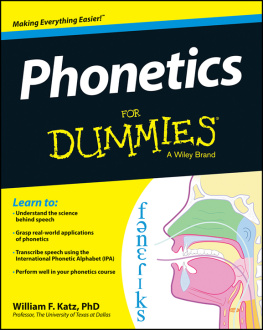


![Katz - Zombie Slayer Box Set, Vol. 1 [Books 1-3]](/uploads/posts/book/141697/thumbs/katz-zombie-slayer-box-set-vol-1-books-1-3.jpg)




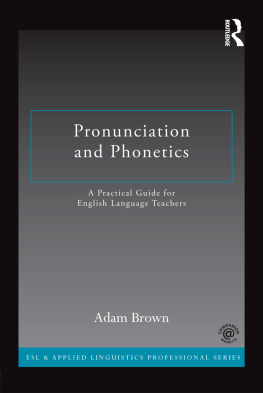




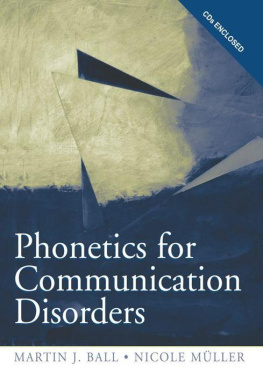
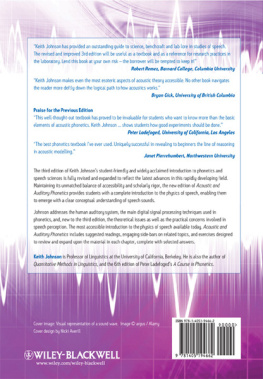


 Study the facts and theory. Phonetics covers a broad range of topics, including physiology, acoustics, and perception, which means you need to familiarize yourself with a lot of new terminology. The more you study, the better youll become.
Study the facts and theory. Phonetics covers a broad range of topics, including physiology, acoustics, and perception, which means you need to familiarize yourself with a lot of new terminology. The more you study, the better youll become.